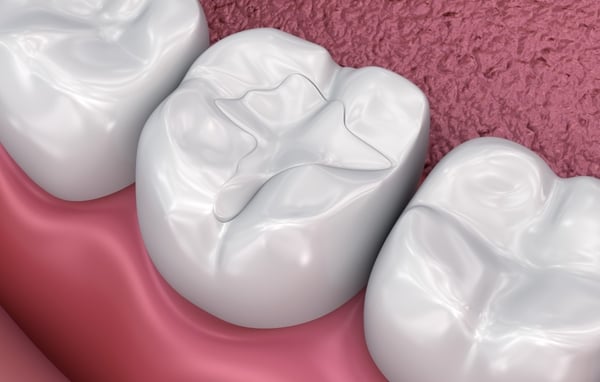
In standard restorative dental practice, the worn or damaged tooth is ground down about 75 percent to a nub. A hollow crown, made to look like the original tooth is cemented over the nub of the original tooth. In preparation for this wasteful, uncomfortable, and even painful process, the dentist may tell the patient that the tooth is too far gone to take further fillings and that it has to replaced with a crown.
The natural tooth is always better than the artificial crown material. Taking care of a crown always takes more work than taking care of a natural tooth.
Issues and Problems with Crowns.
The crown covers the tooth but there is a point at the boundary between the tooth and the natural tooth (called the "margin") where a thin gap can be an entry point for food particles and other substances that can produce tooth decay. It isn't always possible to fully seal the margin and many patients do not adequately clean their teeth to prevent this decay.
In many cases, the margin of the crown may represent an irritant to the surrounding gum and the gum may recede from the tooth at the margin causing looseness and possible gum disease. Foreign material from the cement that remains below the gum line often leads to permanent irritation or gum disease.
The natural tooth sometimes changes color so the color of the crown may noticeably depart from the color of the natural tooth.
The porcelain material in the crown may be more easily subject to cracking or chipping which may lead to decay. So the crown may eventually have to be replaced.
The crown will not prevent the need for root canal treatment if the damage to the original tooth or if decay at the margin or decay in cracks in the porcelain of the crown allows for infection of the pulp or soft tissue inside the original tooth enamel.
Crowns may cost between $500 and $3,000 per tooth, not including dental procedures that may be required before they are applied.
Inlays or Onlays.
If your dentist tells you that you will need a crown, consider available alternatives. Many teeth can be restored without using crowns. Partial coverage inlays or onlays can be a better and more conservative way of saving a tooth without the deep grinding of the original tooth.
These are sometimes known as indirect fillings. They are formed specifically to fit areas of the tooth that need to be covered, then manufactured out of porcelain in a dental laboratory. They can be bonded inside (inlays) the tooth or on the surface of the tooth (onlays) to fill in decayed areas of the tooth.
The fit is carefully tailored so that they fit perfectly against the surface of the tooth which allows for normal brushing and flossing. Inlays can be used as a substitute for fillings. They seal and protect the tooth enamel better than composite fillings. Inlays and onlays preserve as much of the natural tooth structure as possible. There is no margin to increase the likelihood for further decay.
The cost of an onlay is roughly half the cost of a crown. Inlays are slightly more expensive.
Resin Composites.
Using composite resins (tooth-colored plastic and glass) that harden inside the patient's mouth when exposed to primary blue light have also been used successfully to restore teeth without the need for crowns or, for that matter, the use of onlays or inlays. This kind of restoration requires expert dental skills.
The dentist prepares the tooth then applies the resin in layers using a light wand to harden each layer. When the process of laying the resin is completed, the dentist shapes the composite to fit the tooth precisely. Then the dentist polishes the resin to prevent staining and early wear. Recent studies have demonstrated that these resins form long-lasting tooth restorations.
William Linger, DDS, MAGD, a hometown dental practice located in Charlotte, NC, is one of the elite dentists who takes a conservative approach to tooth restoration, using a range of procedures to save as much of your original enamel tooth as he can. Please contact us to find out more.



